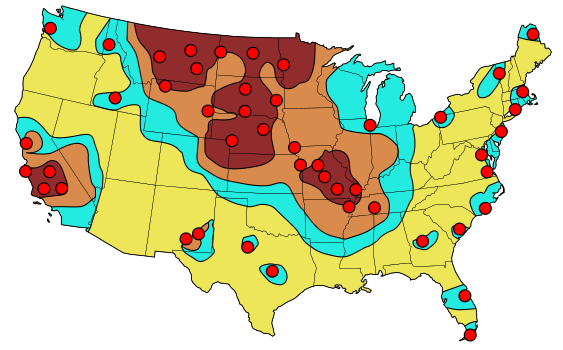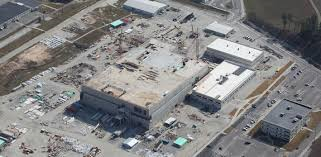
Blog
-
Geiger Readings for March 18, 2014
Ambient office = 101 nanosieverts per hourAmbient outside = 87 nanosieverts per hourSoil exposed to rain water = 109 nanosieverts per hourBanana from QFC = 84 nanosieverts per hourTap water = 100 nanosieverts per hourFiltered water = 91 nanosieverts per hour -
Nuclear Weapons 67 – Ukraine and Nuclear Weapons
I grew up during the Cold War and, as a child, had nightmares of nuclear war. As the Cold War wound down and the nuclear powers agreed to reduce their nuclear arsenals, I thought that I could relax a bit. Now there are people on both sides of the Earth who would like to restart the Cold War.
When the Cold War ended, Ukraine had Soviet nuclear missiles. They decided that they did not want to be a nuclear power and sent the missile to Russia to be dismantled. They obtained a treaty signed by the U.S., the UK, and Russia that Ukraine would be defended by the other signatories of the treaty if threatened by a nuclear power. Just last year, China signed a similar treaty with Ukraine.
Due to the current situation with Russia on the verge of annexing Crimea, some Ukraine officials have said that it might be desirable for Ukraine to obtain nuclear weapons to protect itself. It is an interesting question of how far the U.S., the UK or China would be willing to go to protect Ukraine against Russian aggression.
Recently a news anchor in Russia who appears on the network that is essentially a propaganda wing of the current Russian government said that Russia was the only country that could reduced the United States to radioactive ash in a matter of hours. Recently, a Russian general appeared on Russian TV with an animation showing Russian missiles attacking the U.S. Another Russian General said that there is an automatic system in place that could fire Russian missiles from silos and submarines even if the Russian government had been destroyed in a nuclear attack. Chinese generals have also been talking about nuclear war with the U.S. China has been accusing Japan of planning to create nuclear weapons.
The Unites States and Russia both have around fifteen hundred nuclear missiles aimed at each other. There are protocols in place to launch those missiles within minutes in case of war. There are estimates that the explosion of around a hundred nuclear warheads may be sufficient to cause a nuclear winter that would end human civilization. In a nuclear war, no one wins.
We are now in the most tense international situation with Russia since we experienced the Cuban Missile Crisis in 1973. During that crisis a Soviet ship had navigational problems and crossed the red line created by the U.S. A U.S. naval captain had orders to fire on any Russian ship that crossed that line. If the captain had fired, it might have started a nuclear war. He hesitated long enough to verify that the Russian ship had strayed off course. The fate of the world rested with one man. There have been other close calls during the years of the Cold War.
There are those voices in the U.S. that say that we should take a hard line with Russians over Crimea and even consider military options. I am really afraid that if we do anything like that, we could be on a slippery slope to nuclear war and the end of human civilization. The chancellor of Germany recently said, after talking to Putin, that he was out of touch with reality. If there is any truth to this, the world is entering a very dangerous time.
FEMA-estimated primary counterforce targets for Russian ICBMs. The resulting fall-out is indicated with the darkest considered as “lethal” to relatively fall-out free yellow zones:
-
Radiation News Roundup March 17, 2014
Nuclear Nation a haunting documentary about the Fukushima meltdown. newyorker.com
Monitoring following an incident at a Halifax, Canada, port suggests that containers of uranium hexafluoride dropped by a crane Thursday are not leaking. nuclearstreet.com
A nuclear dump in Western Pennsylvania could contain far more waste than originally thought, the Nuclear Regulatory Commission’s inspector general said in a new report. observer-reporter.com
-
Geiger Readings for March 17, 2014
Ambient office = 89 nanosieverts per hourAmbient outside = 109 nanosieverts per hourSoil exposed to rain water = 77 nanosieverts per hourAsparagus from Central Market = 110 nanosieverts per hourTap water = 146 nanosieverts per hourFiltered water = 130 nanosieverts per hour -
Geiger Readings for March 16, 2014
Ambient office = 89 nanosieverts per hourAmbient outside = 109 nanosieverts per hourSoil exposed to rain water = 77 nanosieverts per hourAsparagus from Central Market = 110 nanosieverts per hourTap water = 146 nanosieverts per hourFiltered water = 130 nanosieverts per hour -
Geiger Readings for March 15, 2014
Ambient office = 95 nanosieverts per hourAmbient outside = 64 nanosieverts per hourSoil exposed to rain water = 81 nanosieverts per hourCelery from Central Market = 96 nanosieverts per hourTap water = 104 nanosieverts per hourFiltered water = 77 nanosieverts per hour -
Nuclear Reactors 109 – Work on US MOX Fuel Fabrication Facility Halted
In the 1960s, it was estimated that there would be a huge global fleet of nuclear power reactors by the year 2000 that would require reprocessing of spent nuclear fuel in order to create more fuel. As the years passed, interest in nuclear power declined and the world reserves of high grade uranium ore increase. When the year 2000 arrived, the global nuclear power reactor fleet turn out to be one tenth of the early estimate and there was sufficient uranium fuel available. Reprocessing of spent fuel to make more fuel is much more expensive than mining and refining uranium. However, there are indications that world uranium production has peaked and that there may be supply problems in the near future. This has spurred renewed interest in breeder reactors and reprocessing with Russia working on a new generation of breeder reactors and reprocessing plants.
In 1999, the U.S. Nuclear Security Administration (NNSA) signed a contract with what is now Shaw Areva MOX Services, LLC. (SAMS). Under the contract, SAMS would design, build and operate a Mixed Oxide (MOX) Fuel Fabrication Facility (MOFFF). This facility would be used to convert plutonium from nuclear weapons into a form that could be used to fuel U.S. nuclear power reactors. To accomplish this, the plutonium would be mixed with uranium oxide to form the fuel pellets used in nuclear reactors. The design would be based on AREVA’s MOX conversion plants in France. The facility was to be constructed at the Savannah River Site operated by NNSA. Under the design, when operational, the facility should be able to convert three and one half metric tons of plutonium into MOX fuel per year.
Currently, most MOX conversion of spent nuclear fuel to recover plutonium is done in the United Kingdom and France with some conversion going on in Russia, India and Japan. China has expressed interest in fast breeder reactors and MOX conversion. With concerns about the world supply of uranium declining, continued use of nuclear power reactors may require increase reprocessing of spent nuclear fuel as well as the use of fast breeder reactors to create plutonium which can then be converted into MOX fuel.
After years of problems at the MOFFF including delays and cost increases, the Obama Administration has decided to halt work on the facility. It was estimated that the reprocessing plant might cost as much as thirty billion dollars over its lifetime. The facility will be put on “cold standby” while the Administration investigates other ways of disposing of or reprocessing spent nuclear fuel from U.S. reactors. Japan has also had a lot of problems with the reprocessing facility that they are working on.
While the intent of MOX creation from weapons grade plutonium is to reduce the amount of weapons grade plutonium in the world, critics have pointed out that during the processing stage, there is an increased risk of theft. There is also the fear that wide use of MOX conversion technology to recover plutonium from spent nuclear fuel which would result in an increase instead of a decrease in the world supply of high grade plutonium, at least during processing. This increases the threat of nuclear proliferation.
MOX Fuel Fabrication Facility at Savannah River Site in South Carolina:





